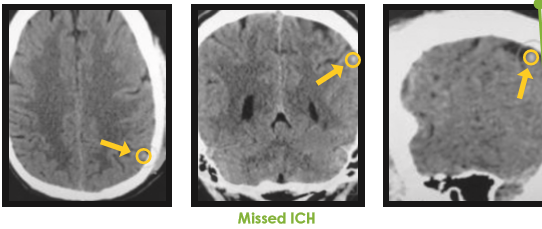Cost- and power-effective medical decision assistant

This use-case refers to a DL-based smart assistant, which supports emergency room situations, identifying acute intracranial bleeds in non-contrast CT images.
Why?
Pilot results of activities studying automated decision support for medical decisions show that initial implementations reach accuracy level that exceeds that of emergency room clinicians. Internal performance results leave room for improvement of response time. Processing happens on a 3D volume, posing significant requirements in terms of computing resources. Desirable response-time depends on the characteristics of each specific clinical case, however it can be estimated that lowering it to around ten seconds would open a wide new landscape of potential clinical use and, consequently, commercial exploitation channels..
Moreover, the implementation of (at least part of) the DL inference on cost-effective embedded computing platforms will also open new options. For example, it will pave the way to implementation of portable devices, suitable to be easily moved from one room to another, connectable to portable imagers, or usable in a wide range of medical operations where network connectivity is not available or unreliable. On the R&D side, the deployment of new solutions is highly demanding in terms of computational resources and effort. This is very limiting in when attempting to maximize the output of scarce research staff, especially when exploring new clinical areas..

Suspected acute ICH found. Object detection and classification in medical images at MaxQ-AI
How?
The consortium wants to assess the benefits provided by the ALOHA tool flow within the development of an embedded medical decision assistant, considering the requirements posed by the specific application in terms of accuracy (few false positives and even fewer false negatives) and performance (possibility of obtaining results in a very short time, utilizing cost-effective hardware).
ALOHA is testing the capability of the tool flow to create runtime-adaptive systems. The decision support assistant should be capable of being set by the clinician to work in different modes for different kinds of intervention corresponding to different battery lifetimes or detection precision.
Moreover, the ALOHA consortium is testing the ability of the flow to enable fast growth into new clinical areas, thanks to the provided productivity improvement.
MaxQ-AI, responsbile for this use case, is at the forefront of Medical Diagnostic Artificial Intelligence (AI). The mission of this field of studies is to meaningfully help reduce misdiagnosis and healthcare costs by making artificial intelligence intrinsic to the diagnostic process for time-sensitive and life-threatening conditions. To do this AI solutions must comprehensively address these conditions and be seamless, trusted, and secure. This work aims to transform healthcare by empowering physicians to provide “smarter care” through intelligent imaging with AI driven actionable insights. Care providers and AI solutions, better together.
To address this growing problem, experts on AI, deep learning, and machine vision, are trying to develop a revolutionary software platform capable of concurrently considering medical imaging along with other data which will provide a comprehensive patient-level assessment that will deliver insight across the diagnosis, prognosis, and therapeutic pathway. For instance, as shown in the images, by improving the detection of intracranial hemorrhage (ICH), skull fracture, and brain contusion, these solutions are being designed to identify, inform, accelerate, and prioritize clinical assessment of these conditions. The ALOHA framework works to integrate into a comprehensive, seamless, and secure workflow to augment acute care teams with deep clinical insight and actionable data in minutes. These AI-powered insights will enable care providers across the world to make rapid and accurate assessments in any location, at any time for acute head trauma, TBI, and stroke symptomatic patient care needs.

Hemorrhage missed on initial interpretation but identified by physician and ALOHA. Object detection and classification in medical images at MaxQ-AI
Intro images: Abstract vector created by macrovector - www.freepik.com
